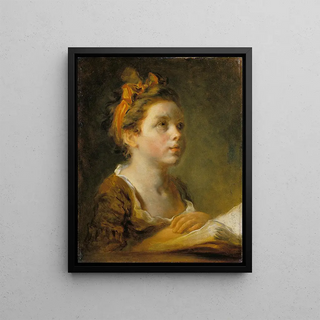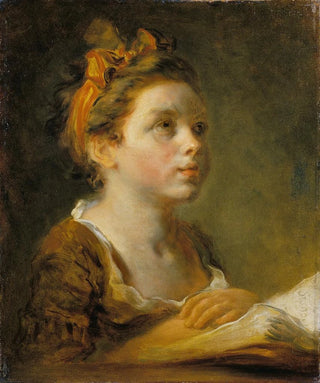Art print | Girl reading a book - Jean-Honoré Fragonard


View from behind

Frame (optional)
In the world of art, some works manage to capture the very essence of beauty and delicacy. "Girl reading a book" by Jean-Honoré Fragonard is undoubtedly one of these creations. Painted in the 18th century, this iconic piece of the Rococo movement evokes an atmosphere of softness and serenity. The young girl, immersed in her reading, embodies intimacy and introspection that transcend time. Through this scene, Fragonard invites us to explore not only the world of literature but also the nuances of the human soul, revealing the magic of a suspended moment.
Style and uniqueness of the work
Fragonard's style is distinguished by its lightness and refinement. In "Girl reading a book," pastel colors, play of light, and delicate details combine to create an atmosphere that is both dreamy and soothing. The young reader, dressed in a light gown, appears absorbed in her book, while a blurred background of greenery suggests a lush garden, symbolizing nature and life. The features of her face, imbued with softness, reveal an emotional depth that engages the viewer. The piece is a perfect example of Rococo aesthetics, where the expression of feelings and the celebration of beauty take precedence over realism. Fragonard succeeds in capturing a moment of escape, a bubble of tranquility in a often restless world.
The artist and his influence
Jean-Honoré Fragonard, born in Grasse in 1732, is an emblematic figure of French Rococo. A pupil of François Boucher, he quickly established himself as a master in genre painting. His work is marked by a unique sensitivity and a keen sense of composition. Fragonard was able to capture the spirit of his time, a moment when art reflected the pleasures of life and the importance of emotions. His influence extends far beyond his era, inspiring many artists through the centuries. The lightness of his style, combined with a deep understanding of human emotions, opened the

Matte finish

View from behind

Frame (optional)
In the world of art, some works manage to capture the very essence of beauty and delicacy. "Girl reading a book" by Jean-Honoré Fragonard is undoubtedly one of these creations. Painted in the 18th century, this iconic piece of the Rococo movement evokes an atmosphere of softness and serenity. The young girl, immersed in her reading, embodies intimacy and introspection that transcend time. Through this scene, Fragonard invites us to explore not only the world of literature but also the nuances of the human soul, revealing the magic of a suspended moment.
Style and uniqueness of the work
Fragonard's style is distinguished by its lightness and refinement. In "Girl reading a book," pastel colors, play of light, and delicate details combine to create an atmosphere that is both dreamy and soothing. The young reader, dressed in a light gown, appears absorbed in her book, while a blurred background of greenery suggests a lush garden, symbolizing nature and life. The features of her face, imbued with softness, reveal an emotional depth that engages the viewer. The piece is a perfect example of Rococo aesthetics, where the expression of feelings and the celebration of beauty take precedence over realism. Fragonard succeeds in capturing a moment of escape, a bubble of tranquility in a often restless world.
The artist and his influence
Jean-Honoré Fragonard, born in Grasse in 1732, is an emblematic figure of French Rococo. A pupil of François Boucher, he quickly established himself as a master in genre painting. His work is marked by a unique sensitivity and a keen sense of composition. Fragonard was able to capture the spirit of his time, a moment when art reflected the pleasures of life and the importance of emotions. His influence extends far beyond his era, inspiring many artists through the centuries. The lightness of his style, combined with a deep understanding of human emotions, opened the






